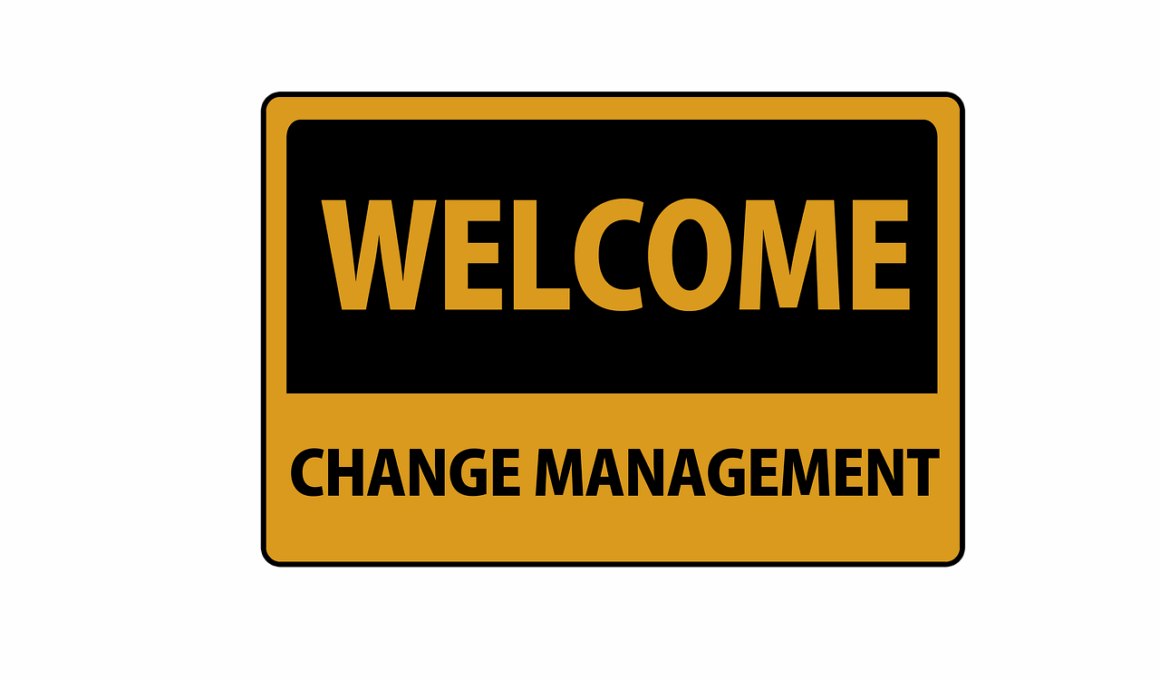Integrating Change Management with Quality Management Systems
Change management is a systematic approach to dealing with change in organizations, emphasizing preparation, support, and the shifting of people. It is essential for businesses to incorporate change management directly into their quality management systems (QMS). This integration ensures that changes to processes, products, or services are carried out smoothly and effectively while minimizing disruption. It promotes a culture where adaptation is part of daily operations, reducing resistance among employees. To be effective, organizations must establish a clear framework that defines roles and responsibilities regarding change initiatives. Furthermore, they should communicate the rationale behind changes comprehensively to all stakeholders. This transparency not just builds trust but also enables employees to be more engaged with the processes involved. Additionally, leveraging data collected through the QMS can provide valuable insights into how changes impact overall quality and performance. Continuous feedback mechanisms should be established to monitor the effectiveness of implemented changes, thus allowing for timely adjustments. Therefore, the integration of change management into the QMS creates a robust platform that enhances organizational resilience and aligns change efforts with strategic objectives, ultimately leading to sustained growth and success.
Quality management systems provide a structured, consistent approach to managing organizational processes, ensuring high levels of quality and performance. Integrating change management into a QMS allows organizations to enhance their capabilities, improving products and services while remaining responsive to market demands. In this approach, both quality and change management work hand-in-hand, fostering an environment of continuous improvement. Implementing standardized processes within a QMS enables better tracking of changes, ensuring that every adjustment can be monitored for impact on product quality. Moreover, organizations should prioritize training and development to equip their teams with the skills necessary for successful change implementation. Employees empowered through effective training become champions of change, contributing positively to the transition phase. Furthermore, it is crucial to identify potential risks associated with changes and formulate adequate risk management strategies. By doing so, organizations can mitigate adverse effects while maintaining quality standards. Utilizing quality management principles, such as the Plan-Do-Check-Act (PDCA) cycle, fosters a culture of iterative enhancement. Ultimately, an integrated approach not only supports smooth transitions but also aligns continuous improvement efforts with organizational goals, solidifying the foundation for long-term success and adaptability.
A successful integration of change management with quality management systems critically hinges on effective communication and stakeholder engagement. Organizations must develop comprehensive communication plans that outline how changes will be communicated to various stakeholders, including employees, management, suppliers, and customers. This ensures that everyone involved is aware of upcoming changes and their potential impact. Creating forums for feedback and discussions allows members to express concerns or suggestions about the impending changes. Such involvement can increase buy-in and reduce resistance to change. Additionally, effective mapping of stakeholders and tailoring messages to specific audiences can yield better engagement and alignment. Furthermore, embracing technology can play a vital role in facilitating communication and data sharing during the change process. Utilizing collaboration tools and platforms can enhance transparency and streamline the participation of stakeholders. Regular updates and check-ins can keep everyone informed, fostering an environment of trust and support. Additionally, setting up mechanisms to celebrate successful changes reinforces positive behaviors within the organization. When employees see tangible benefits from changes, they are more likely to embrace future initiatives, leading to sustained improvement across both change and quality management efforts.
Challenges in Integrating Change Management with QMS
Despite the numerous advantages, integrating change management with quality management systems presents several challenges for organizations. First, resistance to change is a common phenomenon that leaders must effectively address. Employees often feel apprehensive about changes that potentially alter their established routines or ways of working. Such resistance can significantly hinder the success of change initiatives. To combat this, leaders should focus on building a compelling case for change, providing adequate support, and creating an open forum for dialogue. Moreover, ensuring alignment between change initiatives and overall quality objectives is crucial yet often overlooked. Disjointed efforts may occur when the organization fails to correlate changes directly with quality improvements, leading to confusion and misdirection. Therefore, defining clear metrics to evaluate the success of change initiatives against quality goals will aid in addressing this challenge. Furthermore, a lack of resources or insufficient training may impede the change management process. Organizations need to allocate necessary resources effectively and offer comprehensive training to employees, ensuring everyone is equipped to handle new processes or systems. By proactively addressing these challenges, organizations can achieve fruitful integration, fostering an environment where change and quality are seamlessly intertwined.
Monitoring and evaluation are pivotal in assessing the integration of change management with quality management systems. Organizations must establish robust metrics to measure the effectiveness of change initiatives and their impact on quality. These metrics can encompass various factors, including customer satisfaction, process efficiency, and defect rates. Regularly reviewing these indicators will help organizations identify areas needing improvement or adjustment. It is also important to involve stakeholders in the assessment process to gather diverse insights and perspectives. Through feedback, organizations can identify what worked well and what did not, adapting their strategies accordingly. Moreover, leveraging data analytics tools can enhance the evaluation process, providing detailed insights into performance trends and outcomes. With a clear understanding of the implications of changes on quality, organizations can make informed decisions regarding future initiatives. Additionally, continuous improvement should remain a core principle within the organization. Utilizing methods such as root cause analysis enables teams to delve deeper into quality issues, suggesting improvements based on evidence from monitoring efforts. In this manner, the integration of change management and quality management systems shall evolve into a dynamic process that consistently pushes the organization towards higher standards.
Success Stories of Integration
Several organizations have successfully integrated change management with quality management systems, yielding remarkable results. These success stories demonstrate the potential of such integration to drive continuous improvement and enhance operational efficiency. For instance, a manufacturing company implemented a quality management system that streamlined its production process while simultaneously adopting a change management framework to ensure optimal transition. This deliberate approach not only minimized disruptions during the implementation phase but also resulted in a significant decrease in defect rates. Similarly, a healthcare organization integrated its change management efforts with a quality system that focused on patient care. By actively involving staff in the change process and providing thorough training, the organization achieved improved patient satisfaction scores and better health outcomes. Another noteworthy example is a technology firm that utilized change management principles within its quality framework to launch a new product successfully. By aligning its teams through effective communication and stakeholder engagement, the product exceeded initial quality expectations and gained considerable market traction. These examples illustrate how thoughtfully integrating change management with QMS can lead to remarkable enhancements in quality and overall organizational performance.
In conclusion, integrating change management with quality management systems is not merely a tactical necessity; it is a strategic imperative for organizations striving for excellence. As businesses face rapid changes in markets, technologies, and customer expectations, a synchronized approach becomes critical to ensure that quality standards are consistently met. Achieving this integration requires a comprehensive understanding of both management disciplines, along with a commitment to cultivating a culture of continuous improvement. By taking proactive steps to align change efforts with quality objectives, organizations can enhance their resilience and adaptability. It enables a robust framework where change can be embraced rather than feared, thus facilitating innovative practices that drive growth and success. Moreover, developing leaders within the organization who champion both change and quality is essential for sustainable results. With the right leadership approach, organizations can ensure that change initiatives not only complement but also enhance their quality systems. Ultimately, the pathway to an integrated model of change and quality management will pave the way for organizations to thrive in an increasingly dynamic and competitive landscape, serving as a vital foundation for future-oriented thinking and practices.


